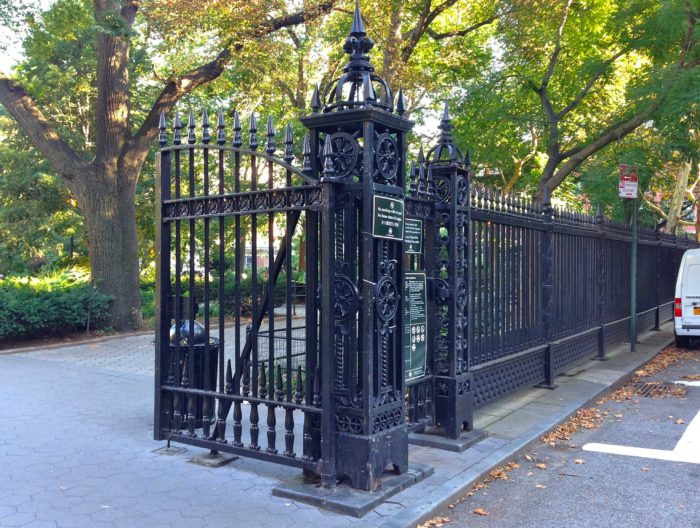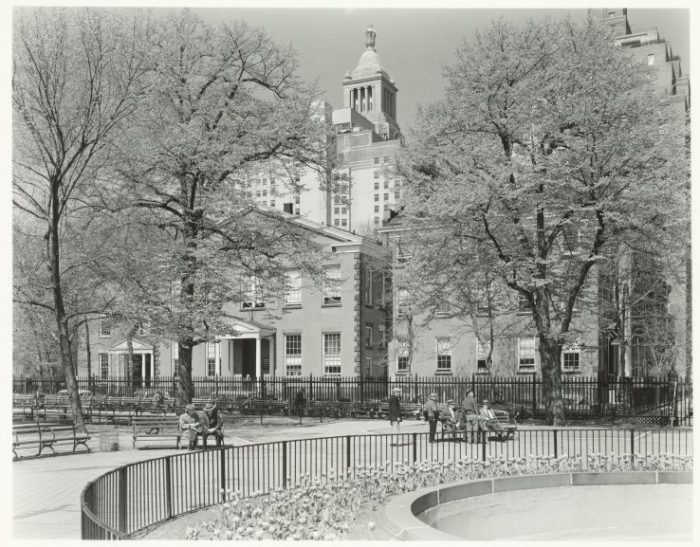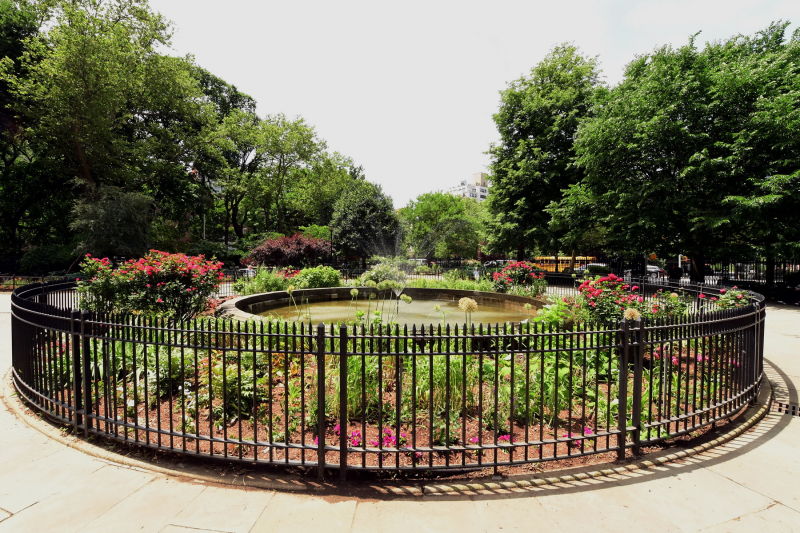Just about every New Yorker, it seems, is familiar with Union Square, with its popular Greenmarket and ornate drinking fountain. And even non-New Yorkers have heard of Gramercy Park, accessible only to residents who possess a key. But when you ask people about Stuyvesant Square, you are apt to get a shrug in response. And that is a shame, because the nearly four-acre park and the historic district it is part of are definitely well worth knowing.
Bisected by Second Avenue, the park spans from East 15th to East 17th Streets; Nathan D. Perlman Place is its eastern border and Rutherford Place its western. This parcel of land was just a small part of the holdings of Peter Stuyvesant, the last Dutch director-general of the 17th-century colony of New Netherland. By the time the Dutch conceded the colony to the English in 1664, Stuyvesant’s 62-acre farm stretched from what is now the Bowery up toward present-day Kips Bay.

Peter Stuyvesant statue by Gertrude Vanderbilt Whitney. Credit: Pooch Ventures
In 1836, Stuyvesant’s great-great-grandson Peter Gerard Stuyvesant sold this piece of the farm to New York for a nominal fee of $5. He certainly did not need the money; he was the nation’s second richest man (only John Jacob Astor was wealthier). His only condition was that the city would turn the land into a public park and build a fence around it to separate it from his surrounding private property. The park was dubbed Holland Park; Rutherford Place was named after P.G. Stuyvesant’s wife, Helen Rutherford; and Nathan D. Perlman Place was originally named Livingston Place after his mother, Margaret Livingston. (The street did not gain its current name until well over a century later; Perlman was a local politician, judge, and executive of the American Jewish Congress.)

The original cast-iron fence. Credit: Ephemeral New York
New York City apparently felt no urgency to build the fence. Three years later, with no fence in sight, the Stuyvesants sued the city, and even then construction did not begin until 1847. The fence surrounding the park today is the original, and the oldest cast-iron gate in the city. Finally, in 1859, the newly fenced-in Stuyvesant Square opened to the public. Peter Gerard, unfortunately, was not alive to enjoy the occasion, as he had drowned in Niagara Falls in 1847. A year before his death, he had donated land adjacent to the park, on the western side of Rutherford Place, for the building of St. George’s Episcopal Church.

Credit: Ephemeral New York

One of the park’s two fountains, with the Friends Meeting House in the background. Credit: Eden, Janine and Jim/Flickr
The park, the church (sometimes called Morgan’s Church because J.P. Morgan was a warden), the establishment of the Friends Meeting House at Rutherford Place and 15th Street in 1860, and the expansion of Second and Third Avenues up to 28th Street all encouraged wealthy importers, manufacturers, and merchants to purchase from Stuyvesant’s heirs properties surrounding the park. George Palmer Putnam, who cofounded what would become the G.P. Putnam’s Sons publishing house, now owned by the Penguin Group, bought a house across from the park on East 16th Street in 1852. Hamilton Fish, a nephew and heir of Peter Gerard Stuyvesant who was the 16th governor of New York and later a U.S. senator and the Secretary of State under President Ulysses S. Grant, lived on East 17th Street. Businessman William E. Dodge, a founding member of the YMCA in the U.S., owned several houses on East 18th Street, living in one from in the 1850s and renting out the others.

Image: NYC Parks
By the end of the 19th century the Stuyvesant Square area had lost some of its luster to Fifth Avenue. Nonetheless, it still attracted a cultured set. Czech composer Antonin Dvorák lived on East 17th Street from 1892 to 1895; the building was razed in the 1990s to make way for the Robert Mapplethorpe Residential Treatment Facility, part of Beth Israel Medical Center. Dvorák composed his “New World Symphony” while living here. Writers William Dean Howells and Elizabeth Jordan lived in the area as well, as did the widow of General Custer. What’s more, fans of the best-selling “The Alienist” and “The Angel of Darkness” know that the books’ fictional protagonist, Dr. Laszlo Kreizler, lived on East 17th Street in the 1880s.

Antonin Dvorák by Ivan Meštrović. Credit: Chasing Dreams
Today the park itself includes a bronze bust of Dvorák by Ivan Meštrović, the first living artist to have a solo show at the Metropolitan Museum of Art. From 1963 through 1997 the sculpture resided on a rooftop terrace of Avery Fisher Hall, but the park that the composer used to regularly walk by was eventually deemed a more appropriate location. The park’s other major monument is a full-figure bronze statue of Peter Stuyvesant by Gertrude Vanderbilt Whitney, who is perhaps better known as the founder of the Whitney Museum of American Art.
Magnificent as those sculptures are, many believe they are outshone by the park’s flora. These include English elms (at least one of which is believed to have been growing here since before Peter Gerard sold the parkland), small-leafed linden trees, sedum, roses, lavender, salvia, and in honor of the Stuyvesants’ Dutch heritage, tulips, including a relatively new cultivar, the Manhattan tulip.
Stuyvesant Square, Then and Now









